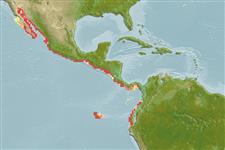Classification / Names
Common names from other countries
Main reference
Size / Weight / Age
Max length : 13.0 cm SL male/unsexed; (Ref. 188); common length : 10.0 cm SL male/unsexed; (Ref. 188)
Environment
Marine; pelagic-neritic; depth range 0 - 50 m (Ref. 188)
Climate / Range
Tropical, preferred ?; 33°N - 5°S, 116°W - 77°W (Ref. 188)
Distribution
Short description
Dorsal
spines
(total): 0;
Dorsal
soft rays
(total): 13-21;
Anal
spines: 0;
Anal
soft rays: 12 - 23. Body moderately slender, quite strongly compressed, belly sharply keeled. The bright silver stripe along the flank distinguishes it from all similar clupeids in the area. Hind border of gill opening evenly rounded (with two fleshy outgrowths in Harengula and Opisthonema, the latter with a filamentous last dorsal fin ray).
IUCN Red List Status (Ref. 115185)
Threat to humans
Harmless
Human uses
Fisheries: minor commercial
More information
Common namesSynonymsMetabolismPredatorsEcotoxicologyReproductionMaturitySpawningFecundityEggsEgg development
ReferencesAquacultureAquaculture profileStrainsGeneticsAllele frequenciesHeritabilityDiseasesProcessingMass conversion
Tools
Special reports
Download XML
Internet sources
Estimates of some properties based on models
Phylogenetic diversity index
PD50 = 0.5625 many relatives (e.g. carps) 0.5 - 2.0 few relatives (e.g. lungfishes)
Trophic Level
3.5 ±0.43 se; Based on food items.
Resilience
High, minimum population doubling time less than 15 months (K=1.36)
Vulnerability
Low vulnerability (10 of 100)
Price category
